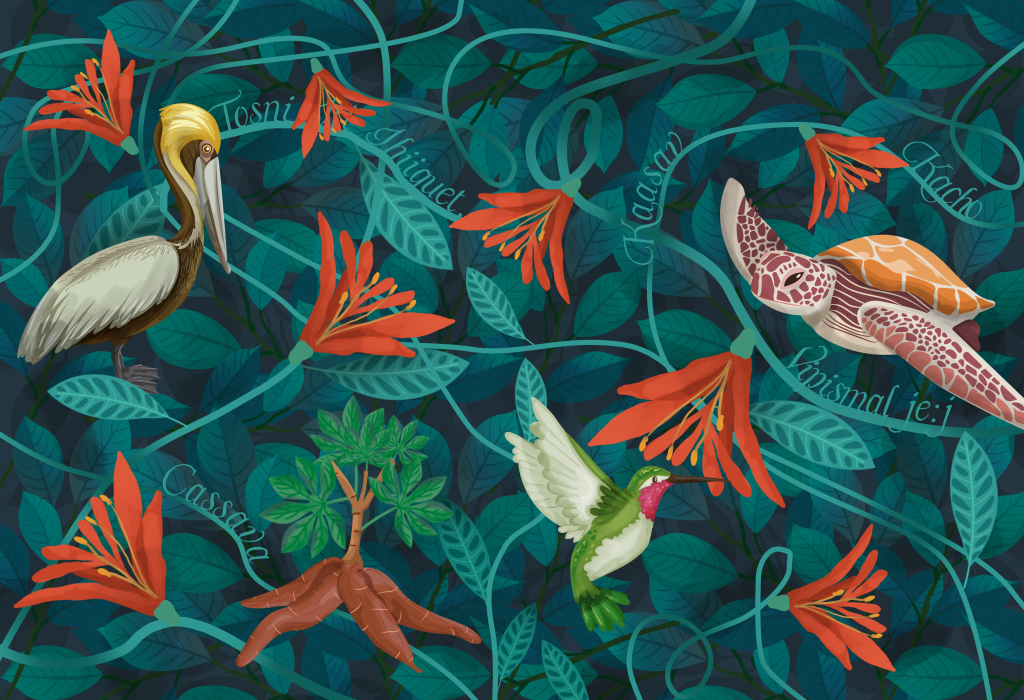Western science emphasises standard, universally agreed upon nomenclature for the natural world based primarily on morphology. In comparison, indigenous or tribal names are often based on animal or plant habitats, kinship systems, uses, relationships with humans and non-human species and/or mythology or taboos. For example, the local name given to the nectar-rich
Justicia californica plant by the Comcáac (Seri) tribe—Noj oopis—translates to “hummingbird’s suckings” and the O’odham tribe name for the same plant—Vipismal je:j—translates to “hummingbird’s mother”.
If regional names reflect the unique culture and local environment in which they are used and encode valuable knowledge about human societies and their interactions with biodiversity, then why might names change over time? Interviews with coastal fishers in the Sindhudurg district of Maharashtra conducted by Aditya Kakodkar found that the local names used for sea turtles in 2006 were different to those shared in a later study conducted by Andrea Phillott and Paloma Chandrachud in 2018.
Earlier, Kurma was used for the giant leatherback turtles, Tupalo for the common olive ridley turtles, and Kasai in reference to all other species. Twelve years later, the names Kaasav, Kasho, Kodam and Kachua were used interchangeably for all sea turtle species. The names have different origins: Kasai is of the regional dialect Konkani, Kaasav means turtles in the state language of Marathi, Kachua is from the northern Indic language Hindi, and Kurma is from the ancient and classical Indian language Sanskrit. Kasho, Kodam, and Tupalo as names for turtles are of unknown origin.
The 2018 study proposes four possible reasons for the changes in local names over time: a) the species of sea turtles encountered by fishers in local waters changed over time, b) the cultural significance of sea turtle species to fishers shifted in the period between the two studies, c) change in language over time, and/or d) the language in which the interview was conducted influenced fishers’ responses. Each of these reasons is of concern to people who value the local names for biodiversity.
Change in species presence or numbers
Knowledge encoded in local names for biodiversity is based on a large timescale and focused on a narrow and specific geographic area and therefore provides valuable, in-depth information about localised environments. Sometimes, these names convey knowledge of past phenomena that are no longer observed. Such a case is the name in the language Cmiique Iitom used by the Seri People to refer to an island in the middle of the Gulf of California – Tosni Iti Ihiiquet, which translates to “where pelicans have their offspring”. Breeding pelicans in the area have declined and don’t use the island in current times but historical records from a naturalist’s journal corroborate the accuracy of the Seri name.
Biodiversity has been declining at an alarming rate worldwide, with the current situation being labelled “the sixth mass extinction”. The major causes of this extinction event are anthropogenic—including pollution, habitat loss, hunting, overexploitation of natural resources, climate change, and introduction of invasive species. However, it is not only biodiversity that will be lost as more and more species become extinct; linguistic extinction will also occur.
This loss is already being recognised: declining specialised knowledge and vocabulary related to plants and animals among the Solega tribe of Karnataka is attributed in part to the introduction of the invasive plant Lantana camara that now dominates the landscape with its dense woody thickets, driving many shorter plants to local extinction. Culturally important herbs and shrubs have become rare and then absent from the immediate environment of the community and are, therefore, spoken about less. This disrupts the transmission of traditional knowledge to younger generations and results in a cultural loss of local names.

Shift in cultural significance of species and language
Cultural knowledge and names can diffuse—meaning items such as language, food and clothing, spread out and merge with pieces from different cultures—and erode—where core cultural elements are lost when replaced with other elements—due to environmental and social change. For instance, the root vegetable cassava had an integral role in the culture of the Amuesha tribe of the Central Peruvian Andes, featuring in their songs, myths and traditions, and being collected, cultivated and traded by the community. The value of cassava was reflected in the vast number of local names assigned to the different cultivated varieties of cassava.
Over time, however, there has been a shift in the cultural significance of cassava, with the younger generation focusing on market-viability and increasing cassava productivity using select varieties over maintaining the diverse range that was traditionally cultivated. Older generations attribute this attitude to the loss of traditional knowledge and language, within which the cultural value of cassava is encoded, through modern schooling. Indeed, there has been a shift in the dominant language used by cassava cultivators in the Peruvian region. Before 2000, cassava varieties were referred to by the indigenous names. In 2022, the names were primarily in Spanish or a combination of Spanish and the indigenous language.
Another case of shifting cultural significance of an indigenous language is evidenced by the Solegas described above. The word tho:pu to older Solegas refers to the tree dominated high-altitude forests that the Solega traditionally live in, while younger Solegas use the word to refer to groves or small clumps of trees. The latter is based on the word for “grove” in the state language Kannada, indicating attrition of their tribal language after increasing contact with mainstream Indian society and institutional pressures.
Similarly, the Amuesha describe displacement of traditional knowledge and indigenous language among younger people with increasing acculturation and assimilation with Spanish culture and modern schooling. There is an imminent risk of the disappearance of many of the world’s languages as well as the wealth of knowledge they carry with increasing migration, acculturation, and integration of linguistic minorities. Sadly, linguists have predicted the extinction of 50–90 percent of world languages by the end of this century. The loss of language will come with a great cost to our knowledge systems about biodiversity.
Influence of research language and method
Among the researchers conducting interviews in the 2018 study of fishers’ names for sea turtles, some spoke Marathi, the state language, and/or Hindi, the common northern Indic language. A few Marathi speakers also knew the regional dialect of Konkani and all were fluent in English. Fishers—who can also be multilingual—were given the choice of which language they wanted to speak during the interview. These conversations in multiple languages in their vicinity could have shaped the way fishers thought about the researchers (and their questions!) and shaped fishers’ cultural mindset when responding. We don’t know which language/s were used in the 2006 interviews, but a difference could also have contributed to the difference in local names used by fishers for sea turtles over time. Similarly, the demographics of fishers interviewed and the wording of the questions asked in the 2006 and 2018 studies may also have been different, resulting in the variation in names over time.
Conclusion
The knowledge that can be gained from understanding local names and the insights into cultural and ecological changes that can be inferred by examining changes in local vocabularies mean that conservationists need to be concerned about more than just threats to biological diversity. Loss of linguistic diversity will result in the loss of indigenous and tribal knowledge systems that are valuable for understanding the natural environment.
To understand, and prevent the loss of, ecological knowledge encoded in regional languages, academics from different fields—such as linguistics, ethnobiology, and ecology—must collaborate and form partnerships with local communities. In the case of the change in local names for sea turtles at Sagareshwar beach in Maharashtra, such collaboration could provide valuable perspectives on if and why the names changed and what this could imply. If the difference over time is the result of encountering fewer, or different species of, sea turtles changing cultural significance or research method, then understanding the cause of the change could determine whether conservation action is needed.
Further Reading
Gorenflo L. J., S. Romaine, R. A. Mittermeier and K. Walker-Painemilla. 2012. Co-occurrence of linguistic and biological diversity in biodiversity hotspots and high biodiversity wilderness areas. Proceedings of the National Academy of Sciences 109(21): 8032-8037.
Phillott A. D. and P. Chandrachud. 2021. Fishers’ ecological knowledge (FEK) about sea turtle in coastal waters: A case study from Vengurla, India. Chelonian Conservation and Biology 20(2): 211-221.
Wilder B. T., C. O’Meara, L. Monti and G. P. Nabhan. 2016. The importance of indigenous knowledge in curbing the loss of language and biodiversity. BioScience 66(6): 499-509.






